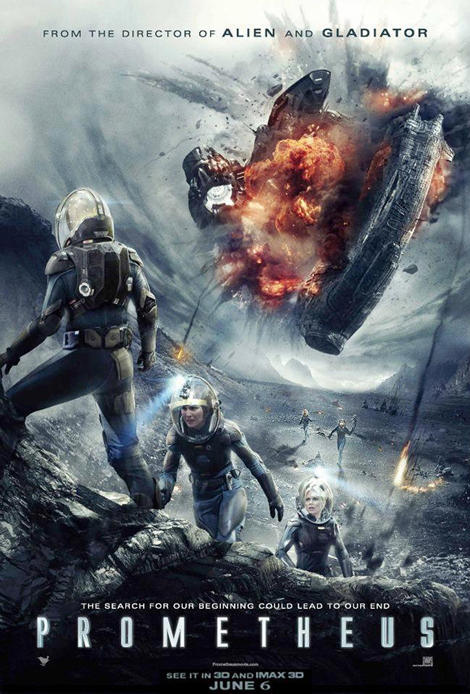 How long after is too long? Returning to a great original is fraught with difficulties at any time, but the more time goes by, the more the problems compound. 2012/2013 presented us with two follow-ups to genre landmarks from 1977/1978. Did we need them? No. Were they worth it? No. Did they do their creators reputations harm? Yes.
How long after is too long? Returning to a great original is fraught with difficulties at any time, but the more time goes by, the more the problems compound. 2012/2013 presented us with two follow-ups to genre landmarks from 1977/1978. Did we need them? No. Were they worth it? No. Did they do their creators reputations harm? Yes.
Normally a sequel is a direct response to the success of the first work, and comes pretty quickly after. But sometimes, sequels arrive so late they are irrelevant to their supposed audience. In 1978 did any cinema goer think, “You know what I’d really like to see? A follow-up to that 34-year-old classic, National Velvet!” Far more people were looking to the future and anticipating Ridley Scott’s second feature, Alien.
Alien generated three sequels by other hands—Aliens, Alien 3 and Alien Resurrection—and two prequels shared with the Predator series. Then, late in his career, and another 18 films on, Scott himself made his own prequel, Prometheus. This was, obviously, a rather more elegant affair than the previous prequels, but it was still a far cry from the quality of Alien, from his other SF classic, Blade Runner, or his fantasy classic, Legend. Prometheus was interesting and entertaining, but it was still a bit of a muddle and littered with silliness. Visually, it was outstanding and exceptionally well made. But it seemed Scott didn’t care as much about the characters, plot, or sense of the thing as he did about the images, set pieces, and technology (on and off screen). Some would argue that nothing much has changed, but Scott seemed more determined than ever to just get the thing made than to have it be something worth making, something that could stand honorably alongside its illustrious antecedent.
But then, Ridley Scott is a changed man. In the early stage of his cinematic career, films came along once every three years. They were an event. They counted for something. But after the brilliant duo of Thelma and Louise (1991) and 1492: Conquest of Paradise (1992), Scott was away from the big screen for an extended hiatus, returning only with the excellent (in parts) White Squall, a film that flopped so badly I was the only person in the cinema when I saw it on opening day. It looked like his career had sunk, that his glory days were over. But then he returned, becoming a machine for churning out commercial pictures as rapidly as possible. Polished, well made pictures of varying quality, but often blandly anonymous. In the first 19 years of his filmmaking career, Scott made 9 films. By contrast, in the last 16 years he has cranked out 12 films. It is hard to believe the same creative talent behind Blade Runner made the ludicrous G.I. Jane or the cookie-cutter thriller Body of Lies.
But Scott isn’t the person he was when he made Alien. None of us are the same person we were 33 years ago. Alien was a visually groundbreaking film that helped redefine the look and feel of SF cinema. Prometheus felt like the slick, polished work of a man who no longer cares so much, but just wants to get the job done and get on to the next (he already has another film out right now, The Counsellor), regardless of quality or even the impact on his own reputation. Perhaps he really just doesn’t care any more. Perhaps its hard to care after so long, after so many films, so much achievement. Scott has nothing to prove, but he does have a reputation to tarnish. If you were stuck on a desert island would you rather have his first four films or his last 12?
 Similarly, Stephen King has just returned to the world of his now-classic third novel, 1977’s The Shining. September saw the much hyped publication of Doctor Sleep, the official sequel to a much greater original. Things didn’t bode well when the title was announced—it had already been used by a little-known 2002 British horror film. So much for originality. It also didn’t bode well when publication was pushed back from pre-Christmas 2012 to late 2013. Was King trying to fix something that just wasn’t working?
Similarly, Stephen King has just returned to the world of his now-classic third novel, 1977’s The Shining. September saw the much hyped publication of Doctor Sleep, the official sequel to a much greater original. Things didn’t bode well when the title was announced—it had already been used by a little-known 2002 British horror film. So much for originality. It also didn’t bode well when publication was pushed back from pre-Christmas 2012 to late 2013. Was King trying to fix something that just wasn’t working?
Well, King is a very different man now to the young author who raised his game to pen The Shining. For one thing, he is 36 years older. He has nothing to prove and only a reputation to tarnish. There are good things about Doctor Sleep, but it is third-rate King. The villains have aspects that are cartoon-ludicrous. While there is suspense, there is little overt horror or terror. The climax is rushed and weak. The book suffers the problem of many follow-ups; where the original was lean and tightly focused, Doctor Sleep throws too many elements into the mix and just gets preposterous. And the protagonist could be any of King’s middle-aged alcoholic heroes. The only surprise this time is that Danny Torrance isn’t a novelist.
Doctor Sleep could still have been a third-rate King novel without the connections to The Shining. It would have done his reputation less harm. For years, King had wisely avoided a sequel. Genre history offered enough examples to show him it was a bad idea—just consider the long-after-the-event sequels Arthur C. Clarke wrote to 2001, or Asimov’s late-in-life attempts to distort his Foundation and Robot stories into one unconvincing future. King must have been aware of this long and tarnished history, but he added to it anyway. Surely it wasn’t for the money. He is both an extremely rich and extremely generous man who gives a considerable amount of money to charitable causes each year. So if it wasn’t a cash grab, then why? King can still write good novels, as Joyland showed earlier this year, and great ones, as 11.22.63 proved not so long ago. But that was a very different novel from The Shining, because King is a very different man.
Ridley Scott and Stephen King are prolific storytellers, and neither has been able to resist the aging artist’s urge to revisit old glories. King recently penned an eighth, creatively unnecessary, addition to his Dark Tower series. Scott is planning a sequel to his greatest work, Blade Runner. Will aging artists ever learn that this sort of thing is never, ever a good idea? Making a great sequel or prequel right after the original is to beat the odds, but to do it 30 or more years later is all but impossible. The artist has changed, we have changed, the world has moved on and what was fresh and original can now be nothing more than a minor variation on a theme. Perhaps we need a moratorium, say, a seven year period (the time between The Terminator and Terminator 2: Judgement Day), after which artists can no longer make sequels to their own work. To save us from disappointment, and to save them from themselves.











Interesting points. I don’t entirely agree with you, but I can understand why you feel the way that you do. I thought, while reading Dr. Sleep, that it was useful as an illustration of how horror has changed in the last 36 years. It felt truly modern to me, for better or worse, but it injected some good ol’ classic horrifics (like the ghost of the little boy oozing brains). I had fallen out of reading horror literature as much, gravitating more towards the visual, and it was great to be reminded of the strengths of that particular medium.
I do not feel like it was too late to be relevant; that there were moments that were genuinely moving and inspired (even if reminiscent of some of his other work, like The Green Mile). Some of the villains were rather cartoonish, I definitely agree, but then exaggerated and made kind of bloodchilling, rather along the lines of Pennywise from It.
Thanks for a well-written, thoughtful and informative article. I appreciate your expertise and commitment to genre fiction, even if we do not necessarily see eye to eye (I agree with you about Ridley Scott, though, even though I haven’t seen Prometheus yet).